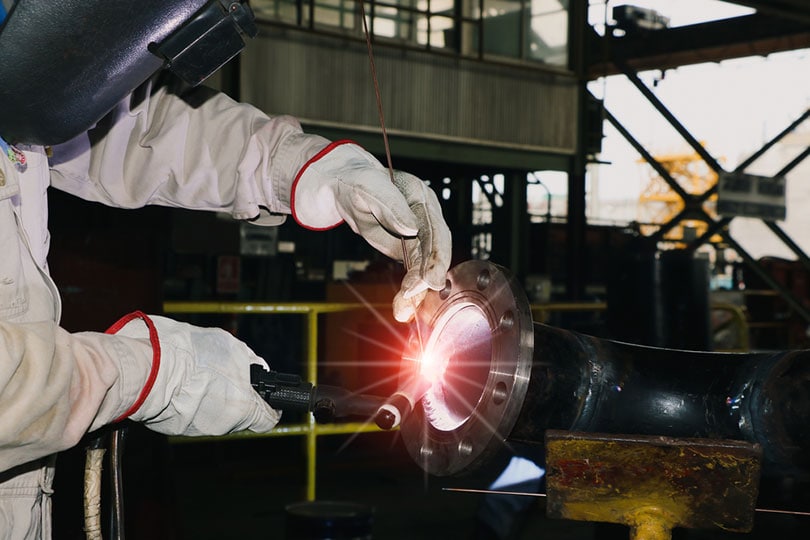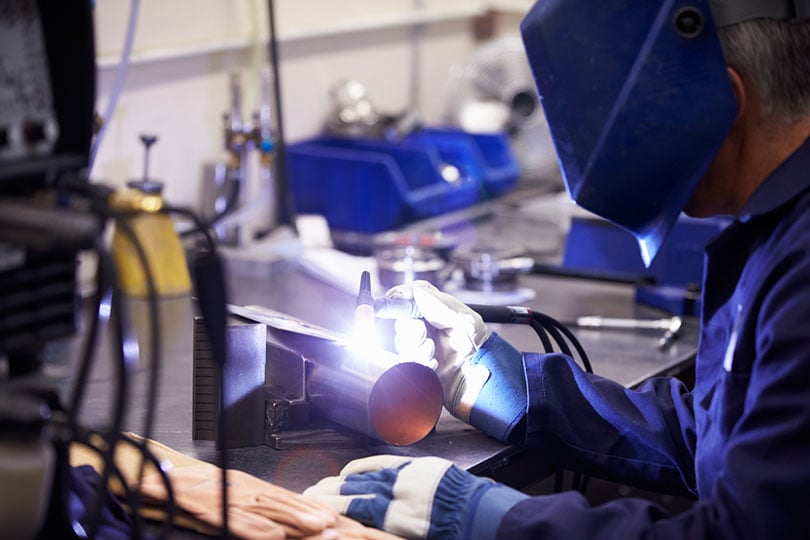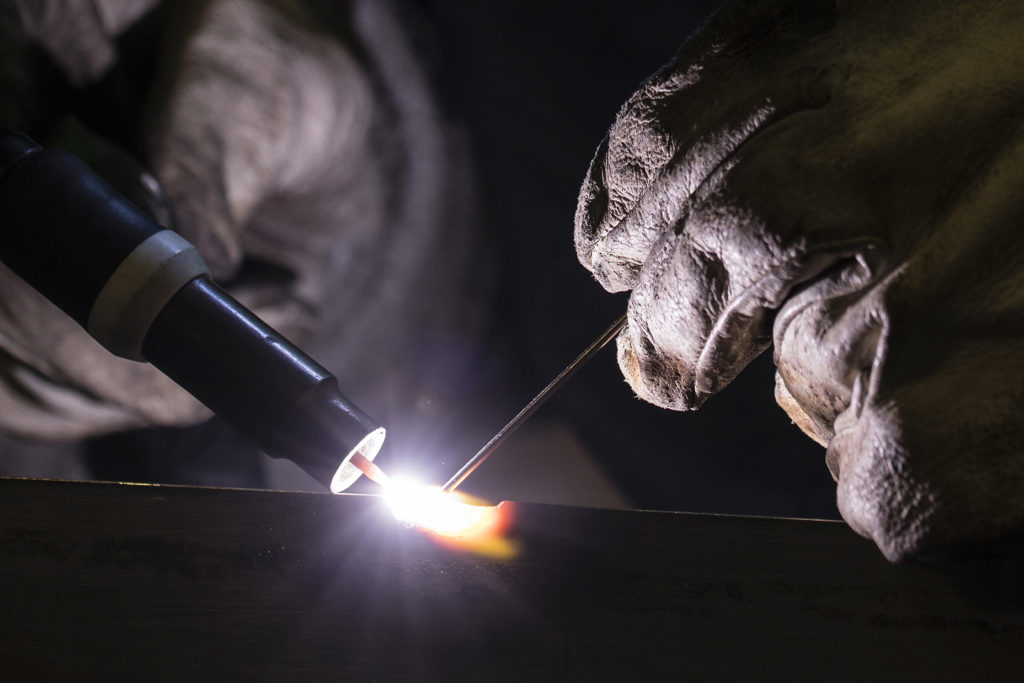Can You Weld Magnesium? What You Need to Know!
Last Updated on

Magnesium is a silver-white, lightweight, strong, ductile, and malleable metal used to make other alloys. Its lightweight and strength enhance the mechanical characteristics of other alloy metals without increasing their weight. One question that is mostly asked is whether magnesium can be welded. Yes, it can be welded using the Tungsten Inert Gas magnesium process, which offers high-quality welds.
You can weld magnesium to repair machine casting and parts. However, note that it is trickier to weld because it’s highly flammable. The metal burns at a temperature of 4,000˚F and a flashpoint of 883˚F. This heat that can turn carbon dioxide and even water into fuel.
Magnesium is not used in large amounts or on its own because it tends to combust and corrode. Its alloys are used in automotive, aircraft, computers, cell phones, and other electronic goods. Ignited pure magnesium is used in flares and fireworks because it burns easily and brightly. Besides, magnesium hydroxides and oxides help increase building materials and plastics’ fire and heat resistance.
This article will look at how to weld magnesium and the safety precautions to observe in the process.
What Makes Magnesium Challenging to Weld
There is a great similarity between welding magnesium and aluminum. The two metals have the same appearance, so it’s good to know how to differentiate them so that you can work on each accordingly. When welding magnesium and aluminum, the difference occurs in the amount of soot created, the arc length distance, and the welding technique itself.
- Highly flammable – when it catches fire, the metal can burn at 4,000˚F.
- Porous metal – Its microscopic structure has tiny pores that make magnesium castings absorb a lot of oil, leading to high fire risks.
- The shavings from cleaning and grinding magnesium can burst into fire. So, the welding area must be cleaned thoroughly after the work.
- Magnesium alloys that are heat-treated to enhance strength are highly sensitive to high temperatures. The strength of the material is affected when the alloys get too hot.

How to Weld Magnesium: Before You Start
Determine that the metal you are welding is magnesium
After understanding the reasons to be extra cautious when welding magnesium, you should determine that the metal you want to weld is actually magnesium. A simple way is to apply white vinegar to the casting. Magnesium reacts with the vinegar causing a fizzing action. This is magnesium reacting with an acid to form magnesium ethanoate and hydrogen gas.
Identify the alloy metal you are working on
Next, you should identify the magnesium alloy you are working on. Some of the alloys include magnesium/zinc alloy, magnesium/aluminum alloy, magnesium/zirconium, or it may be pure magnesium. It’s good to know that each has distinct requirements for pre- and post-heat treatment and filler metals. Identifying the alloy allows you to select the right filler metal, electrode, and voltage setting.
Welding Magnesium Using Tungsten Inert Gas Welding
Tungsten inert welding uses argon and helium gasses. Shielding is necessary because of the reactive nature of magnesium. Helium and argon are the best inert gasses to prevent oxidation. This is the best welding method since it produces high-quality and strong welds.
You can use direct current electrode negative polarity or any other alternative current. If your magnesium has a thickness of more than 4.8 mm, you should use an alternating current because it offers deeper penetration.
You can use both DC and AC currents for magnesium with low thickness. When using direct current, you use helium as it offers better shielding compared to argon. If you use alternating current, argon is the best option to use.
Below are the steps to follow.

1. Prepare the Metal for Welding
After identifying the magnesium alloy, you should prepare the cast for welding.
- Determine the part of the metal to be welded.
- After identification, grind the part to lay the beads of filler down. Use a coarse carbide burr to grind. Also, make sure you have a stainless-steel wire brush.
- Since the metal is highly porous, it’s usually soaked with oil; use 40 ounces of sodium nitrate, 1/8 ounces of calcium fluoride, and 24 ounces of chromic acid and add water to make one gallon of the solution. Soak several times to get a suitable welding surface. Allow the metal to soak for an hour before rinsing in cold and then hot water, and check if the oil residue is removed completely. Before cleaning, you should preheat the metal in an oven to allow the oil to melt out.
2. Prepare Welding Equipment
Now that you have cleaned and prepared the metal to be welded, you should get the correct setup for your equipment. You should change some settings to get the appropriate weld.
- Adjust the arc length on your electrode and ensure that the arc distance is very close to the electrode.
- Do not use older filler that has been exposed to the air for more than a month because your magnesium will oxidize. The filler will have a large amount of oxygen and be fully oxidized, resulting in a weak weld. Use a new filler and clean it until it becomes shiny and oxygen-free before welding.
- Select zirconium alloyed tungsten electrodes for better results and efficiency.
- Use argon gasses for shielding and backup.
- Set your welding equipment to ac and make the right adjustments to effectively allow the filler wire puddle.
- Turn on the welding machine.
- Set the feed wire speed and inspect the welding gun wire.
- Start the magnesium welding process.
What to Focus on While Welding Magnesium
As you weld magnesium, there are several things you should pay attention to. For example, if you face challenges getting filler wire to puddle correctly, you should stop, burr the part again and clean using a wire brush. Note that welding magnesium results in a lot of dirt because of the zinc in the alloy. The soot created makes it hard for you to lay down a bead one after another immediately because the surface contact is reduced.
Ensure that the metal puddles are in the right way to get high-quality weld. You will get a clean and high-quality weld without a great puddle from the wire filler. However, under the welding surface, it will have a lot of holes that compromise your weld’s integrity. If you need to fill a large area of the metal with many beads’ layers to get the suitable fill, you should stop with each bead and clean using the wire brush before you continue filling. The process is tedious, but you need to do it to get a high-quality magnesium weld.
Knowing the type of magnesium alloy you are using is critical because each may be heat treated to enhance strength. The heat-treated alloys are prone to a reduction in material strength if too much heat is applied to them.
If you work quickly when laying down several beads, you may not have enough time to let the heat produced by welding be absorbed by the metal or dissipate. You need to understand the inter-pass heat tolerance of your magnesium alloy to prevent this problem.

Safety Precautions When Welding Magnesium
- Magnesium is highly flammable, so you must take the right precautions to enhance safety. You need to have all the protective equipment such as gloves, goggles, among others.
- Avoid having shavings, dust, or sharp filling near the welding area to avoid catching sparks.
- Perform magnesium welding in an area with the proper ventilation system.
- Have a bucket of sand, graphite-based powders, and dry powdered sandstone near the area to put off fire. If possible, have a Class D fire extinguisher.
How to Prevent Cracking
Some magnesium alloys are susceptible to cracking, so you need strategies to prevent this. You can use starting and stopping plates that are butted with opposite ends of the joint plates. The weld starts at the starting place and ends only when it reaches the stopping plate.
The whole pass is performed in a single shot. To get the desired results, ensure these plates have the same groove design as the main joint.
You can also prevent cracking by beginning the welding in the middle of the joint and moving towards the ends.
Post Care for Magnesium Welding
Like with any other great welding practice, as you finish magnesium welding, you must thoroughly inspect to ensure you have a high-quality weld. You can use X-ray equipment or an FPI to trace down all cracks that may have occurred in the welding process. When you are happy with your magnesium weld, clean the metal and apply a corrosion preventative on it, and you are done with the job.
Final Thoughts
Magnesium can be welded but you have to be cautious since it is highly flammable. The shavings that result when you grind the metal can also burst into flames, so make sure you clean the area after the welding process.
Tungsten inert gas welding is the best method to weld magnesium because it produces strong welds. Helium and argon are the most appropriate welding gasses used since they offer high-level shielding and prevent rapid oxidation by the metal. You must apply all the necessary precautions to prevent fire and have all the necessary equipment, including a Class D fire extinguisher.
Featured Image Credit: Tawansak, Shutterstock
